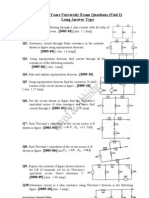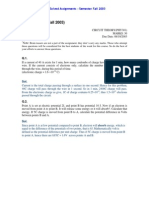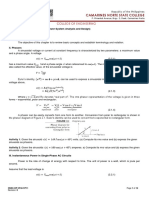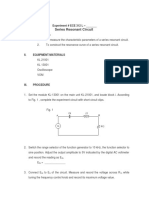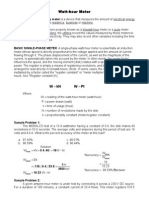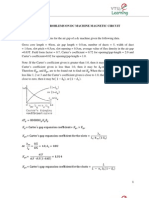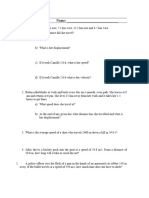Module DC Machines Lesson 3
Uploaded by
Russel BubanModule DC Machines Lesson 3
Uploaded by
Russel BubanELECTRICAL MACHINE 1 Lesson 3: Internal Generated Voltage and Induced Torque Equations
3 INTERNAL GENERATED VOLTAGE AND INDUCED TORQUE
EQUATIONS OF REAL DC MACHINES
What is this Lesson about?
In this lesson we will discuss the equation in determining internal generated voltage and induced
torque in a real DC machine. Factors affecting the magnitudes of both the internally generated voltage
and induced torque are identified. Sample problems are also provided to demonstrate how the
equations are being used.
What Will You Learn? What Do You Already Know?
At the end of the lesson, you should be (PRE-TEST)
able to do the following:
✓ identify and discuss the factors that
affect the magnitude of generated
voltage and induced torque;
✓ Derive and use the internal generated
voltage equation of a DC machine; and
✓ Derive and use the induced torque
equation of a DC machines.
To achieve the said outcomes, this
lesson is divided into the following sub-topics:
• Introduction
• Internally Generated Voltage
• Induced Torque
• Sample problems involving voltage or
torque
What You Should Already Know?
Before taking this lesson, you are expected
to be knowledgeable in the following topics:
✓ Faraday’s Law
✓ Fundamentals of Electromagnetism
✓ Magnetic Fields and circuits
✓ Electric Circuit Analysis
✓ Ohm’s Law
DEMATERA & GEALONE | Bicol University | 1
ELECTRICAL MACHINE 1 Lesson 3: Internal Generated Voltage and Induced Torque Equations
Let us READ! INTERNALLY GENERATED VOLTAGE
INTRODUCTION
The internally generated voltage in any
given DC machine depends on three factors:
Since DC machines are classified into
1. The flux (Φ) in the machine
two, DC Motors and DC Generators, we are also
2. The speed (ω) of the machine's rotor
interested in two distinct outputs. For DC
3. A constant depending on the construction
generators the output is electrical energy. One
of the machine
of the parameters in determining electrical
energy output of a DC Generator is its internally
Voltage Equation
generated voltage (armature voltage). For DC
Motors, the output is mechanical energy.
The voltage out of the armature of a
Primarily, this mechanical energy is in the form
real machine is equal to the number of
of rotational motion, which is defined by a
conductors per current path times the voltage
torque. So, for DC Motors, we are interested in
on each conductor.
induced torque.
In this lesson, we will consider the
The voltage in any single conductor
process of deriving the equation for both
under the pole faces was previously shown to
parameters and determine the factors that
be:
affect them. We will also present some solve
𝑒𝑖𝑛𝑑 = 𝑒 = 𝑣𝛽𝑙
sample problems for us to be familiar in using
the derived equations.
Where v is the velocity of the conductor,
Β is the flux density, and l is the length of the
conductor.
(a) (b)
Figure 3-1: (a) Illustration of DC motor with mechanical rotation as output, expressed in torque; (b) Illustration of DC Generator with
electrical energy output expressed in volts.
Courtesy: https://www.meritnation.com/ask-answer/question/difference-between-dc-motar-and-dc-generator-with-
diagram/magnetic-effects-of-electric-current/13205497
DEMATERA & GEALONE | Bicol University | 2
ELECTRICAL MACHINE 1 Lesson 3: Internal Generated Voltage and Induced Torque Equations
To solve for the total voltage induced, 𝐸𝐴 = 𝑘𝛷𝜔
we multiply e with the total number of
conductors and divided by the number of Based on the above equation, we have
parallel paths. confirmed that flux (Φ) and machine speed (ω)
are factors in voltage generation.
𝑍 𝑣𝛽𝑙𝑍
𝐸𝐴 = 𝑣𝛽𝑙 × =
𝑎 𝑎 Furthermore, since in practice it is
customarily express the speed of the machine
Where Z is the total number of in revolution per minute rather than radian per
conductors and a is the number of parallel second, we can replace ω (in rad/sec) with N (in
current paths. rev/min or rpm):
Since the motion is in the form of
rotation, the velocity can be expressed in terms 2𝜋
Recall: 𝜔 = 𝑁
of angular velocity (v = rω). Substituting the 60
value of v:
Substituting the value of ω:
𝑣𝛽𝑙𝑍 (𝑟𝜔)𝛽𝑙𝑍 𝑟𝜔𝛽𝑙𝑍
𝐸𝐴 = = =
𝑎 𝑎 𝑎
𝑍𝑃 𝑍𝑃 2𝜋 𝑃𝑍
𝐸𝐴 = ( ) 𝛷𝜔 = ( )( )𝛷 = 𝑁𝛷
We can further simplify the equation 2𝜋𝑎 2𝜋𝑎 60 60𝑎
above by noting the following:
Therefore, the equation for internally generated
1. Flux density, Β = Φ/AP voltage in a DC machine is:
2. Area, A = 2r (surface area of
cylindrical rotor) 𝑷𝒁
𝑬𝑨 = ( ) 𝑵𝜱 = 𝒌′𝑵𝜱
3. Area under a pole, AP = 2r/P 𝟔𝟎𝒂
Substituting the values of B and AP:
𝑟𝜔𝛽𝑙𝑍 𝑟𝜔𝑙𝑍 𝛷 𝑟𝜔𝑙𝑍𝛷 𝑃 Example 3-1
𝐸𝐴 = = × = × A duplex lap-wound armature is used in a six-
𝑎 𝑎 𝐴𝑃 𝑎 2𝜋𝑟𝑙
pole dc machine with six brush set each
𝑍𝑃𝛷𝜔 𝑍𝑃
𝐸𝐴 = =( ) 𝛷𝜔 spanning two commutator segments. There are
2𝜋𝑎 2𝜋𝑎
72 coils on the armature, each containing 12
turns. The flux per pole in the machine is 0.039
Note that the term (ZP/2a) is constant for Wb, and the machine spins at 400 rpm. (a) How
a specific machine (i.e., it is determined during many current paths are there in this machine?
construction, and cannot be changed once the (b) How many conductors are there in the
machine is already built). Hence, the formula armature? (c) What is its induced voltage EA?
above can be reduced to:
DEMATERA & GEALONE | Bicol University | 3
ELECTRICAL MACHINE 1 Lesson 3: Internal Generated Voltage and Induced Torque Equations
Given: Example 3-2
Machine type: duplex lap wound A 12-pole dc generator has a simplex wave-
No. of poles: 6 wound armature containing 144 coils of 10 turns
No. of coils: 72 each. The resistance of each turn is 0.011 Ω. Its
No. of turns per coil: 12 flux per pole is 0.05 Wb, and it is turning at a
Flux per pole: 0.039 Wb speed of 200 rpm. (a) How many current paths
Speed: 400 rpm are there in this machine? (b) What is the
induced armature voltage of this machine? (c)
Required: (a) a; (b) Z; (c) EA What is the effective armature resistance of this
machine?
Solution:
Solve for a: Given:
Since the machine is lap wound, the number of Machine type: simplex wave wound
armature current path is: No. of poles: 12
𝑎 = 𝑚𝑃 No. of coils: 144
𝑎 = (2)(6) [duplex, 6-pole]
No. of turns per coil: 10
𝒂 = 𝟏𝟐 current paths
Flux per pole: 0.05 Wb
Speed: 200 rpm
Solve for Z:
Rturn = 0.011 Ω
𝑍 = 2𝐶𝑁𝐶
𝑍 = 2 × 72 × 12 [72 coils, 12 turns/coil]
𝒁 = 𝟏𝟕𝟐𝟖 conductors Required: (a) a; (b) EA; (c) RA
Solve for EA: Solution:
𝑃𝑍 Solve for a:
𝐸𝐴 = ( ) 𝑁𝛷
60𝑎 Since the machine is wave wound, the number
of armature current path is:
Substitute the given and calculated values: 𝑎 = 2𝑚
𝑎 = (2)(1) [simplex]
6 × 1728 𝒂 = 𝟐 current paths
𝐸𝐴 = [ ] × 400𝑟𝑝𝑚 × 0.039𝑊𝑏
60 × 12
Solve for Z:
𝑬𝑨 = 𝟐𝟐𝟒. 𝟔𝑽 𝑍 = 2𝐶𝑁𝐶
𝑍 = 2 × 144 × 10 [144 coils, 10 turns/coil]
𝑍 = 2880 conductors
Solve for EA:
𝑃𝑍
𝐸𝐴 = ( ) 𝑁𝛷
60𝑎
DEMATERA & GEALONE | Bicol University | 4
ELECTRICAL MACHINE 1 Lesson 3: Internal Generated Voltage and Induced Torque Equations
Substitute the given and calculated values:
ACTIVITY 3-1
12 × 2880
𝐸𝐴 = [ ] × 200𝑟𝑝𝑚 × 0.05𝑊𝑏 Instruction: In a letter-sized paper, answer the
60 × 2 following questions. Present a complete solution.
Upload your answer in pdf format to this link.
𝑬𝑨 = 𝟐𝟖𝟖𝟎 𝑽
1. An eight-pole, 25-kW, 120-V dc generator has
a duplex lap-wound armature which has 64
Solve for RA:
coils with 16 turns per coil. Its rated speed is
There are two parallel paths (a) through
2400 rpm.
the rotor of this machine, each one consisting a) How much flux per pole is required to
of Z/2 = 1440 conductors, or 720 turns (2 produce the rated voltage in this
conductors per turn). Therefore, the resistance generator at no-load conditions?
in each current path is: b) What is the current per path in the
armature of this generator at the rated
load?
𝑅𝐴/𝑝𝑎𝑡ℎ = 𝑅𝑝𝑒𝑟 𝑡𝑢𝑟𝑛 × 𝑡𝑢𝑟𝑛𝑠
c) How many brushes must this motor have?
𝑅𝐴/𝑝𝑎𝑡ℎ = 0.11Ω × 720 How wide must each one be?
𝑅𝐴/𝑝𝑎𝑡ℎ = 7.92Ω d) If the resistance of this winding is 0.011 Ω
per turn, what is the armature resistance
For the total armature resistance, recall RA of this machine?
that the total resistance in parallel circuits is
2. A four-pole, wave-wound generator has 220
expressed by:
coils of 10 turns each. The resistance of each
turn is 0.02 Ω. Find the resistance of the
𝑅
𝑅𝑇 = (for “n” equal resistors R connected in parallel) armature winding.
𝑛
3. A four-pole, lap-wound motor with 16 slots, 42
Therefore, the total armature resistance
conductors per slot, 480 V, runs at 1800 rpm.
is:
Find the flux produced per pole.
7.92
𝑅𝑇 = Ω
2 4. What is the voltage induced in the armature
winding of a 4-pole wave wound DC machine
𝑹𝑻 = 𝟑. 𝟗𝟔 Ω having 728 active conductors and running at 1
,600 rpm? The flux per pole is 30 mWb.
5. A four-pole DC generator has an armature
containing 4 elements per slot and 48 slots per
pole. The armature is simplex lap-wound. The
flux per pole is 2,500,000 Maxwell and the
speed of the armature is 1500 rpm. Calculate
the total voltage generated in the armature?
DEMATERA & GEALONE | Bicol University | 5
ELECTRICAL MACHINE 1 Lesson 3: Internal Generated Voltage and Induced Torque Equations
INDUCED TORQUE 1. Flux density, Β = Φ/AP
2. Area, A = 2r (surface area of
The induced torque in any given DC cylindrical rotor)
machine depends on three factors: 3. Area under a pole, AP = 2r/P
1. The flux (Φ) in the machine
Substituting the values of B and AP:
2. The armature (or rotor) current, IA, in the
machine 𝑍𝑟𝑙𝛽𝐼𝐴 𝑍𝑟𝑙𝐼𝐴 𝛷 𝑍𝑟𝑙𝐼𝐴 𝛷 𝑃
𝜏𝑖𝑛𝑑 = = × = ×
3. A constant depending on the construction 𝑎 𝑎 𝐴𝑃 𝑎 2𝜋𝑟𝑙
of the machine 𝑍𝑃𝛷𝐼𝐴 𝑍𝑃
𝜏𝑖𝑛𝑑 = =( ) 𝛷𝐼𝐴
2𝜋𝑎 2𝜋𝑎
Torque Equation
Note that the term (ZP/2a) is constant for
The torque on the armature of a real
a specific machine (i.e., it is determined during
machine is equal to the number of conductors,
construction, and cannot be changed once the
Z, times the torque on each conductor.
machine is already built). Hence, the formula
The torque in any single conductor
above can be reduced to:
under the pole faces was previously shown to
be:
𝝉𝒊𝒏𝒅 = 𝑘𝛷𝐼𝐴
𝜏𝑐𝑜𝑛𝑑 = 𝑟 𝐼𝑐𝑜𝑛𝑑 𝛽 𝑙
Based on the above equation, we have
Where r is the effective radius of the
confirmed that flux (Φ) and armature current (IA)
rotor, Icond is the current in a single conductor, Β
are factors in induced torque.
is the flux density, and l is the length of the
conductor.
𝒁𝑷
If there are a current path in the 𝝉𝒊𝒏𝒅 = (
𝟐𝝅𝒂
) 𝜱𝑰𝑨 = 𝒌𝜱𝑰𝑨
machine, then the total armature current IA is
split among the a current paths, so the current
in a single conductor is given by NOTE: Both the internal generated voltage and
the induced torque equations just given are
𝐼𝐴 only approximations, because not all the
𝐼𝑐𝑜𝑛𝑑 =
𝑎 conductors in the machine are under the pole
faces at any given time and also because the
Since there is Z number of conductors, surfaces of each pole do not cover an entire
the total torque is: rotor's surface. To achieve greater accuracy, the
𝑍𝑟𝑙𝛽𝐼𝐴 number of conductors under the pole faces
𝜏𝑖𝑛𝑑 =
𝑎
could be used instead of the total number of
conductors on the rotor.
We can further simplify the equation
above by noting the following:
DEMATERA & GEALONE | Bicol University | 6
ELECTRICAL MACHINE 1 Lesson 3: Internal Generated Voltage and Induced Torque Equations
Example 3-3 2880 𝑉
𝐼𝐴 =
A 12-pole dc generator has a simplex wave- 1000 Ω
wound armature containing 144 coils of 10 turns
𝐼𝐴 = 2.88 𝐴
each. The resistance of each turn is 0.011 Ω. Its
flux per pole is 0.05 Wb, and it is turning at a
Substituting the values to the equation:
speed of 200 rpm. If a 1-kΩ resistor is connected
to the terminals of this generator, what is the 𝑍𝑃
resulting induced counter-torque on the shaft 𝜏𝑖𝑛𝑑 = ( ) 𝛷𝐼𝐴
2𝜋𝑎
of the machine? (Ignore the internal armature
resistance of the machine.) 2880 × 12
𝜏𝑖𝑛𝑑 = ⌊ ⌋ × 0.05𝑊𝑏 × 2.88𝐴
2×𝜋×2
Given:
𝝉𝒊𝒏𝒅 = 𝟑𝟗𝟔 𝑵 ∙ 𝒎
Machine type: simplex wave wound
No. of poles: 12
No. of coils: 144
Example 3-4
No. of turns per coil: 10
A small two-pole lap wound dc motor with
Flux per pole: 0.05 Wb
eight rotor coils and four turns per coil has a flux
Speed: 200 rpm
per pole of 12.5 mWb. If this motor is loaded
Rload = 1000 Ω
down so that it consumes 50 W from a 12-V
battery, what will the induced torque of the
Required: torque, τ
motor be? (Ignore any internal resistance in the
motor.)
Solution:
Solve for τ:
𝑍𝑃 Given:
𝜏𝑖𝑛𝑑 = ( ) 𝛷𝐼𝐴 No. of poles: 2
2𝜋𝑎
No. of coils: 8
From Example 3-2, the values of Z and a, No. of turns per coil: 4
Flux per pole: 0.0125 Wb
Z = 2880 a=2 Vinput = 12V
Pinput = 50 W
To determine IA, use Ohm’s Law given the load
resistance (and ignore the armature resistance Required: torque, τ
as stated in the problem), and the value of
voltage calculated in Example 3-2. Solution:
Solve for τ:
𝑉 𝑍𝑃
𝐼𝐴 = 𝜏𝑖𝑛𝑑 = ( ) 𝛷𝐼𝐴
𝑅𝑙𝑜𝑎𝑑 2𝜋𝑎
DEMATERA & GEALONE | Bicol University | 7
ELECTRICAL MACHINE 1 Lesson 3: Internal Generated Voltage and Induced Torque Equations
Determine the values of Z and a, ACTIVITY 3-2
For lap wound rotor: Instruction: In a letter-sized paper, answer the
a = mP following questions. Present a complete solution.
Upload your answer in pdf format to this link.
a = (1)(2)
a = 2 current paths
1. An eight-pole, 25-kW, 120-V dc generator has
Z = 2CNC a duplex lap-wound armature which has 64
Z = 2×8×4 coils with 16 turns per coil. Its rated speed is
Z = 64 conductors 2400 rpm.
a) How much flux per pole is required to
produce the rated voltage in this
To determine IA, we use the input power and
generator at no-load conditions?
voltage (and ignore the armature resistance as b) What is the current per path in the
stated in the problem): armature of this generator at the rated
load?
𝑃 = 𝑉𝐼𝐴 c) What is the induced torque in this
machine at the rated load?
𝑃 50𝑊
𝐼𝐴 = =
𝑉 12𝑉 2. A DC motor takes an armature current of 110 A
at 480 V. The machine has 6-poles and the
𝐼𝐴 = 4.17 𝐴 armature is lap-connected with 864 conductors.
The flux per pole is 0.05 Wb (Ignore armature
Substituting the values to the equation: circuit resistance). Calculate:
a) the rotor speed
b) the gross torque developed by the
𝑍𝑃
𝜏𝑖𝑛𝑑 = ( ) 𝛷𝐼𝐴 armature.
2𝜋𝑎
3. A 250-V, 4-pole, wave-wound d.c. series motor
64 × 2
𝜏𝑖𝑛𝑑 =⌊ ⌋ × 0.0125𝑊𝑏 × 4.17𝐴 has 782 conductors on its armature. The motor
2×𝜋×2
takes a current of 40 A. Estimate its speed and
gross torque developed if it has a flux per pole
𝝉𝒊𝒏𝒅 = 𝟎. 𝟓𝟑 𝑵 ∙ 𝒎 of 25 mWb (Ignore armature circuit resistance).
4. A 4-pole, DC motor has a wave-wound
armature with 65 slots each containing 6
conductors. The flux per pole is 20 mWb.
Calculate the motor speed and torque
developed when the machine is operating from
a 250-V supply and taking a current of 60 A.
DEMATERA & GEALONE | Bicol University | 8
ELECTRICAL MACHINE 1 Lesson 3: Internal Generated Voltage and Induced Torque Equations
ASSESSMENT
POST-TEST
Take time to take the Post-Test for this
lesson to check your learning. Please refer to the
lesson if you score less than 80%. The Post-Test can
be accessed in the course site.
ASSESSMENT TASK
Download the provided problem set
under “Assessment Activity 2” on the course
site; Analyze each problem and solve the
required; prepare a complete solution for each
problem; prepare a clean and organized
solution compilation of the problems; and
submit it in the given link.
REFERENCES
Theraja, B. L., & Sedha, R. S. (2006). T.B. Of electrical
technology Vol IV (M.E.). S. Chand.
Chapman, S. J. (2012). Electric machinery
fundamentals. McGraw-Hill Medical Publishing.
Theraja, B. L. (2005). Basic electrical engineering in
S.I. system of units. S. Chand.
Gross, C. A. (2006). Electric machines. CRC Press.
Fitzgerald, A., Fitzgerald, A. E., Kingsley, C., &
Umans, S. (2003). Electric machinery. McGraw-Hill
Professional.
DEMATERA & GEALONE | Bicol University | 9
You might also like
- A Guidebook For Government Jobs - Farrukh Nadeem0% (1)A Guidebook For Government Jobs - Farrukh Nadeem333 pages
- DC Machinery Fundamentals 2: Internal Generated Voltage and Induced Torque Equation For Real DC MachineNo ratings yetDC Machinery Fundamentals 2: Internal Generated Voltage and Induced Torque Equation For Real DC Machine10 pages
- Commutation and Armature Construction Lesson 1: What Is This Lesson About?No ratings yetCommutation and Armature Construction Lesson 1: What Is This Lesson About?9 pages
- DC Circuits Basic Electricity Electrostatics ElectromagneticsNo ratings yetDC Circuits Basic Electricity Electrostatics Electromagnetics4 pages
- A Transistor May Be Operated in Three Different ConfigurationsNo ratings yetA Transistor May Be Operated in Three Different Configurations7 pages
- Circuit Theory - Solved Assignments - Semester Fall 2003No ratings yetCircuit Theory - Solved Assignments - Semester Fall 200335 pages
- Series Resonant Circuit: Experiment # ECE 312 LNo ratings yetSeries Resonant Circuit: Experiment # ECE 312 L4 pages
- Single-Phase Transformer Lab Report: Load TestNo ratings yetSingle-Phase Transformer Lab Report: Load Test3 pages
- The Analysis and Simulation of Voltage Distribution Over String Insulators With Guard Ring Using Matlab/SimulinkNo ratings yetThe Analysis and Simulation of Voltage Distribution Over String Insulators With Guard Ring Using Matlab/Simulink5 pages
- Transformers: Engr. Michael Ernie F. Rodriguez Instructor INo ratings yetTransformers: Engr. Michael Ernie F. Rodriguez Instructor I18 pages
- EE02-Electrical-Transient-Analysis_April-2025No ratings yetEE02-Electrical-Transient-Analysis_April-20254 pages
- EI6402 Electrical Machines Question BankNo ratings yetEI6402 Electrical Machines Question Bank19 pages
- Experiment 3 Title - Separately-Excited DC GeneratorsNo ratings yetExperiment 3 Title - Separately-Excited DC Generators11 pages
- Solved Problems On DC Machine Magnetic Circuit Continuation of Chapter 4-VkNo ratings yetSolved Problems On DC Machine Magnetic Circuit Continuation of Chapter 4-Vk14 pages
- Chapter 7: DC Machinery Fundamentals: V 48 M 5 - 0 M 25 - 0 500 Rad/sNo ratings yetChapter 7: DC Machinery Fundamentals: V 48 M 5 - 0 M 25 - 0 500 Rad/s12 pages
- Influence of System Parameters Using Fuse Protection of Regenerative DC DrivesFrom EverandInfluence of System Parameters Using Fuse Protection of Regenerative DC DrivesNo ratings yet
- Martin J. King - Section 5.0 - Derivation and Correlation of The Viscous Damping CoefficientNo ratings yetMartin J. King - Section 5.0 - Derivation and Correlation of The Viscous Damping Coefficient16 pages
- What Are The Roots of The Polynomial: A. - 3, - 4 B. 6, 2 C. 2, 3 D. 3, 4No ratings yetWhat Are The Roots of The Polynomial: A. - 3, - 4 B. 6, 2 C. 2, 3 D. 3, 438 pages
- Homework05 Engineering Thermodynamics MENG 3320: Answer:0.945 KWNo ratings yetHomework05 Engineering Thermodynamics MENG 3320: Answer:0.945 KW7 pages
- 3/2 AH-WRT™ - Horizontal Pump: InstallationNo ratings yet3/2 AH-WRT™ - Horizontal Pump: Installation3 pages
- Experiment#6 DC Circuit Analysis: Electrical Circuits Lab 0905212No ratings yetExperiment#6 DC Circuit Analysis: Electrical Circuits Lab 090521212 pages
- Design AND Fabrication OF Homemade Air C PDFNo ratings yetDesign AND Fabrication OF Homemade Air C PDF2 pages
- Facile synthesis of CuMn2O4 nanoparticles for efficient of high performance electrode materials for s (1)No ratings yetFacile synthesis of CuMn2O4 nanoparticles for efficient of high performance electrode materials for s (1)12 pages
- Class Ix (Science) : SESSION: 2021-2022 Handout On Gravitation (Physics) CHAPTER-11 (PART-1)No ratings yetClass Ix (Science) : SESSION: 2021-2022 Handout On Gravitation (Physics) CHAPTER-11 (PART-1)4 pages
- Electrical power systems technology 3rd Edition Dale R. Patrick download100% (2)Electrical power systems technology 3rd Edition Dale R. Patrick download58 pages
- Lecture 2 - CML 231 - Atomic Bonding and Structure of Solids100% (1)Lecture 2 - CML 231 - Atomic Bonding and Structure of Solids115 pages
- Power Converters and Ac Electrical Drives With Linear Neural Networks by Maurizio Cirrincione Marcello Pucci and Gianpaolo Vitale PDFNo ratings yetPower Converters and Ac Electrical Drives With Linear Neural Networks by Maurizio Cirrincione Marcello Pucci and Gianpaolo Vitale PDF632 pages





